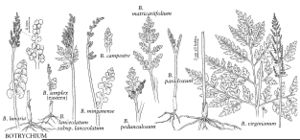Difference between revisions of "Botrychium campestre"
Amer. Fern J. 76: 39, figs. 2, 4, 5. 1986.
FNA>Volume Importer |
imported>Volume Importer |
||
| (7 intermediate revisions by 2 users not shown) | |||
| Line 8: | Line 8: | ||
}} | }} | ||
|common_names=Prairie moonwort;botryche champètre | |common_names=Prairie moonwort;botryche champètre | ||
| + | |special_status={{Treatment/ID/Special_status | ||
| + | |code=F | ||
| + | |label=Illustrated | ||
| + | }}{{Treatment/ID/Special_status | ||
| + | |code=E | ||
| + | |label=Endemic | ||
| + | }}{{Treatment/ID/Special_status | ||
| + | |code=C | ||
| + | |label=Conservation concern | ||
| + | }} | ||
|basionyms= | |basionyms= | ||
|synonyms= | |synonyms= | ||
| Line 17: | Line 27: | ||
}}<!-- | }}<!-- | ||
| − | --><span class="statement" id="st- | + | --><span class="statement" id="st-undefined" data-properties=""><b>Trophophore </b>stalk usually absent but sometimes broadly tapered to 10 mm in forms with coalesced proximal pinnae; blade glaucescent, oblong, longitudinally folded when alive, 1-pinnate, to 4 × 1.3 cm, very fleshy. <b>Pinnae</b> to 5(–9) pairs, spreading, usually remote, separated 1–3 times pinna width, in some populations irregularly and extensively fused with considerable webbing along rachis, distance between 1st and 2d pinnae not or slightly more than between 2d and 3d pairs, basal pinna pair approximately equal in size and cutting to the adjacent pair, mostly linear to linear-spatulate, undivided to tip, margins crenulate to dentate, usually notched or cleft into 2 or several segments, apex rounded to acute, venation like ribs of fan, midrib absent. <b>Sporophores</b> 1(–2, rarely)-pinnate, 1–1.5 times length of trophophore. <b>2n</b> =90.</span><!-- |
-->{{Treatment/Body | -->{{Treatment/Body | ||
| + | |phenology=Leaves appearing in early spring and dying in late spring and early summer, long before those of associated moonworts. | ||
|habitat=Extremely inconspicuous in prairies, dunes, grassy railroad sidings, and fields over limestone | |habitat=Extremely inconspicuous in prairies, dunes, grassy railroad sidings, and fields over limestone | ||
|elevation=50–1200 m | |elevation=50–1200 m | ||
|distribution=Alta.;Ont.;Sask.;Colo.;Iowa;Mich.;Minn.;Mont.;Nebr.;N.Y.;N.Dak.;S.Dak.;Wis.;Wyo. | |distribution=Alta.;Ont.;Sask.;Colo.;Iowa;Mich.;Minn.;Mont.;Nebr.;N.Y.;N.Dak.;S.Dak.;Wis.;Wyo. | ||
| − | |discussion=<p>Botrychium campestre is one of four moonwort species that commonly produce dense clusters of minute, spheric gemmae at the root bases. Peculiar forms of B. campestre with coalescent pinnae are found on dunes in the vicinity of Lake Michigan.</p><!-- | + | |discussion=<p><i>Botrychium campestre</i> is one of four moonwort species that commonly produce dense clusters of minute, spheric gemmae at the root bases. Peculiar forms of <i>B. campestre</i> with coalescent pinnae are found on dunes in the vicinity of Lake Michigan.</p><!-- |
--><p>Of conservation concern.</p> | --><p>Of conservation concern.</p> | ||
|tables= | |tables= | ||
| Line 33: | Line 44: | ||
-->{{#Taxon: | -->{{#Taxon: | ||
name=Botrychium campestre | name=Botrychium campestre | ||
| − | |||
|authority=W. H. Wagner & Farrar | |authority=W. H. Wagner & Farrar | ||
|rank=species | |rank=species | ||
| Line 40: | Line 50: | ||
|basionyms= | |basionyms= | ||
|family=Ophioglossaceae | |family=Ophioglossaceae | ||
| + | |phenology=Leaves appearing in early spring and dying in late spring and early summer, long before those of associated moonworts. | ||
|habitat=Extremely inconspicuous in prairies, dunes, grassy railroad sidings, and fields over limestone | |habitat=Extremely inconspicuous in prairies, dunes, grassy railroad sidings, and fields over limestone | ||
|elevation=50–1200 m | |elevation=50–1200 m | ||
| Line 46: | Line 57: | ||
|publication title=Amer. Fern J. | |publication title=Amer. Fern J. | ||
|publication year=1986 | |publication year=1986 | ||
| − | |special status= | + | |special status=Illustrated;Endemic;Conservation concern |
| − | |source xml=https:// | + | |source xml=https://bitbucket.org/aafc-mbb/fna-data-curation/src/2e0870ddd59836b60bcf96646a41e87ea5a5943a/coarse_grained_fna_xml/V2/V2_295.xml |
|genus=Botrychium | |genus=Botrychium | ||
|subgenus=Botrychium subg. Botrychium | |subgenus=Botrychium subg. Botrychium | ||
|species=Botrychium campestre | |species=Botrychium campestre | ||
| − | |||
| − | |||
| − | |||
| − | |||
| − | |||
| − | |||
| − | |||
| − | |||
| − | |||
| − | |||
| − | |||
| − | |||
| − | |||
| − | |||
| − | |||
| − | |||
| − | |||
| − | |||
| − | |||
| − | |||
| − | |||
| − | |||
| − | |||
| − | |||
| − | |||
| − | |||
| − | |||
}}<!-- | }}<!-- | ||
-->[[Category:Treatment]][[Category:Botrychium subg. Botrychium]] | -->[[Category:Treatment]][[Category:Botrychium subg. Botrychium]] | ||
Latest revision as of 21:22, 5 November 2020
Trophophore stalk usually absent but sometimes broadly tapered to 10 mm in forms with coalesced proximal pinnae; blade glaucescent, oblong, longitudinally folded when alive, 1-pinnate, to 4 × 1.3 cm, very fleshy. Pinnae to 5(–9) pairs, spreading, usually remote, separated 1–3 times pinna width, in some populations irregularly and extensively fused with considerable webbing along rachis, distance between 1st and 2d pinnae not or slightly more than between 2d and 3d pairs, basal pinna pair approximately equal in size and cutting to the adjacent pair, mostly linear to linear-spatulate, undivided to tip, margins crenulate to dentate, usually notched or cleft into 2 or several segments, apex rounded to acute, venation like ribs of fan, midrib absent. Sporophores 1(–2, rarely)-pinnate, 1–1.5 times length of trophophore. 2n =90.
Phenology: Leaves appearing in early spring and dying in late spring and early summer, long before those of associated moonworts.
Habitat: Extremely inconspicuous in prairies, dunes, grassy railroad sidings, and fields over limestone
Elevation: 50–1200 m
Distribution

Alta., Ont., Sask., Colo., Iowa, Mich., Minn., Mont., Nebr., N.Y., N.Dak., S.Dak., Wis., Wyo.
Discussion
Botrychium campestre is one of four moonwort species that commonly produce dense clusters of minute, spheric gemmae at the root bases. Peculiar forms of B. campestre with coalescent pinnae are found on dunes in the vicinity of Lake Michigan.
Of conservation concern.
Selected References
None.
